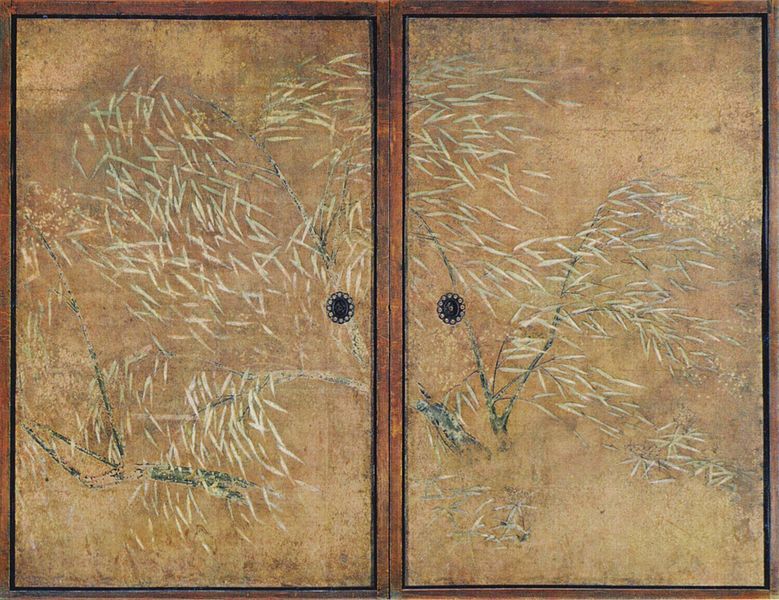 1
1title: Weidenbäume
artist: Kanō eitoku
date: circa 1589
medium: de 1=Schiebetür
dimensions: Size cm 174 227
current location: de|1=Sambo-in, Daigo-ji de|1=Kioto
source: Yorck
credit: The Yorck Project () 10.000 Meisterwerke der Malerei (DVD-ROM), distributed by DIRECTMEDIA Publishing GmbH. ISBN: 3936122202.
license:Public domain
 2
2title: Kano Eitoku 010
artist: User:Quadell. photo of work by Kaihō Yūshō or Kanō eitoku
date: 9 July 2005
source: Photograph (by [[User:Quadell]]) of a 16th century work by en:Kaihō Yūshō in the workshop of en:Kanō eitoku
credit: Photograph (by User:Quadell) of a 16th century work by en:Kaihō Yūshō in the workshop of en:Kanō eitoku
description: A screen painting depicting people of the Ming Dynasty playing Go, by Kanō eitoku. (NB: The detail in this illustration comes from a pair of folding screens The Four Accomplishments that were originally attributed to Kanō eitoku on the basis of seals that appear on each half of the pair. The screens, however, have been demonstrated by the art historian Takeda Tsuneo to be the work of Kaihō Yūshō, a painter who studied with the Kanō workshop). One of six folding screens: ink on paper. Shows people playing Go. Japan, Momoyama period, 16th century. On exhibit at the Sackler Gallery at the Smithsonian Institution.
license:Public domain
 3
3title: Kano Eitoku Cypress Trees
artist: Attributed to Kanō eitoku
date: 1590?
medium: eight folded screen; Ink on paper covered with gold leaves
dimensions: 169.5 x 460.5 cm
current location: Tokyo, Japan Tokyo National Museum (東京国立博物館)
source: [link Emuseum]
credit: Emuseum
license:Public domain
4
title: Kano Eitoku 002a
artist: Kanō eitoku
date: 16th century
medium: Six-fold screen; color, ink and gold-leaf on paper.
dimensions: size cm 88 178
current location: Tokyo, Japan Sannomaru Shozokan (三の丸尚蔵館)
source: self-scanned
credit: Self-scanned
license:Public domain
 5
5title: 檜図屏風
artist: Kanō eitoku
date: Azuchi-Momoyama period, 16th century
medium: en Color and gold leaf on paper
dimensions: w460 x h170 cm
current location: Tokyo National Museum
credit: WgG8VxnsSPYalQ at Google Cultural Institute maximum zoom level
license:Public domain
 6
6title: MET 29 100 495
artist: Kanō eitoku
date: 16th century
medium: Hanging scroll; ink, color, and gold on gilded paper
dimensions: 61 1/8 x 45 1/2in. (155.3 x 115.6cm)
current location: Institution:Metropolitan Museum of Art
source: link Template:TheMet
credit: This file was donated to Wikimedia Commons as part of a project by the Metropolitan Museum of Art. See the Image and Data Resources Open Access Policy
license:
CC0
 7
7title: MET DT1598
artist: Kanō eitoku
date: 17th century
medium: Six-panel folding screen; ink and color on gilt paper
dimensions: 65 1/4 x 146 1/4in. (165.8 x 371.5 cm)
current location: Institution:Metropolitan Museum of Art
source: link Template:TheMet
credit: This file was donated to Wikimedia Commons as part of a project by the Metropolitan Museum of Art. See the Image and Data Resources Open Access Policy
license:
CC0
 8
8title: Kano Tan’yū The Four Seasons - 1992.394.2 - Cleveland Museum of Art
artist: kano Tan’yū
date: 1668
medium: Six-panel folding screen, ink and slight color on paper
dimensions: Image: 174 x 381 cm (68 1/2 x 150 in.)
current location: institution:Cleveland Museum of Art
source: link
credit: link
description:
Tan'yū's skills were honed early within the regimen of the kano family's painting studio. His grandfather, eitoku (1543–1590) was the Momoyama period's most sought-after painter, a champion of colorful, large-scale painting compositions who worked for several of the country's most powerful leaders. When the young Tan'yū was summoned to Edo in 1617 by the shogun to become a member of the new capital's official painting studio, few opportunities to work on similarly ambitious projects existed. Yet by the end of his career, Tan'yū had supervised the execution and installation of linked mural painting compositions in several of Japan's most prestigious residences and castles. As an official court painter to the first shogun, Tokugawa Ieyasu (reigned 1603–5), and then his successors, Tan'yū appears to have successfully juggled his official duties with private activities as a teacher, as the era's leading connoisseur of classic Chinese and Japanese painting, and as a practicing artist. His surviving compositions as well as thousands of sketches far surpass the oeuvre of any of his contemporaries. While studio assistants surely contributed to his oeuvre, just as later imitators consciously confused his accomplishments, a clearer image of the painter has emerged in recent years that better conforms with his contemporary acclaim as recorded in seventeenth- and eighteenth-century documents.
Tan'yū can now be seen as an artist adept in virtually all traditional ink painting subject matter, which he often presented in novel interpretations. Equally important are his rare screen (byōbu) compositions executed in a pure yamato-e manner with vivid mineral pigments on a gold-foil background. This pair of byōbu presents Tan'yū's more orthodox approach to academic ink painting methods embracing Chinese themes that had been interpreted by numerous Japanese ink painters over the centuries. Thus a typical view of residences and human activities set along the shores of an impressive river (or lake) is enlivened by the Japanese proclivity for including seasonal references. Proceeding from right to left, the viewer passes sequentially from spring to the snow-laden branches of winter.
Tan'yū lends considerable atmospherics to the panorama in his use of misty cloud banks, frequently set off by sharp, darkened ink lines or whole areas of ink washes of variegated tonalities. The spring and summer views are particularly notable in this regard, as is the presence of the artist's signature on both byōbu, attesting to their completion in Tan'yū's sixty-seventh year (1668)—50 years after he left Kyoto for the capital, and 30 years following his adoption of the artist name "Tan'yū" (in 1635). From 1622, when he began work on the mural paintings for Edo castle (the shogun's formal residence), through the completion of the painting cycle in 1636 for the Tokugawa family mausoleum in Nikkō to the north of Edo, Tan'yū's skills as head of an accomplished painting studio as well as a master painter found their most impressive expression in large-scale compositions. In 1638 he received the honorary Buddhist title Hōgen (Eye of the Law). It is intriguing therefore that relatively few independent byøbu paintings from the master's hand survive, particularly documented early works.license:
CC0
 9
9title: Kano Tan’yū The Four Seasons - 1992.394.1 - Cleveland Museum of Art
artist: kano Tan’yū
date: 1668
medium: Six-panel folding screen, ink and slight color on paper
dimensions: Image: 174 x 381 cm (68 1/2 x 150 in.)
current location: institution:Cleveland Museum of Art
source: link
credit: link
description:
Tan'yū's skills were honed early within the regimen of the kano family's painting studio. His grandfather, eitoku (1543–1590) was the Momoyama period's most sought-after painter, a champion of colorful, large-scale painting compositions who worked for several of the country's most powerful leaders. When the young Tan'yū was summoned to Edo in 1617 by the shogun to become a member of the new capital's official painting studio, few opportunities to work on similarly ambitious projects existed. Yet by the end of his career, Tan'yū had supervised the execution and installation of linked mural painting compositions in several of Japan's most prestigious residences and castles. As an official court painter to the first shogun, Tokugawa Ieyasu (reigned 1603–5), and then his successors, Tan'yū appears to have successfully juggled his official duties with private activities as a teacher, as the era's leading connoisseur of classic Chinese and Japanese painting, and as a practicing artist. His surviving compositions as well as thousands of sketches far surpass the oeuvre of any of his contemporaries. While studio assistants surely contributed to his oeuvre, just as later imitators consciously confused his accomplishments, a clearer image of the painter has emerged in recent years that better conforms with his contemporary acclaim as recorded in seventeenth- and eighteenth-century documents.
Tan'yū can now be seen as an artist adept in virtually all traditional ink painting subject matter, which he often presented in novel interpretations. Equally important are his rare screen (byōbu) compositions executed in a pure yamato-e manner with vivid mineral pigments on a gold-foil background. This pair of byōbu presents Tan'yū's more orthodox approach to academic ink painting methods embracing Chinese themes that had been interpreted by numerous Japanese ink painters over the centuries. Thus a typical view of residences and human activities set along the shores of an impressive river (or lake) is enlivened by the Japanese proclivity for including seasonal references. Proceeding from right to left, the viewer passes sequentially from spring to the snow-laden branches of winter.
Tan'yū lends considerable atmospherics to the panorama in his use of misty cloud banks, frequently set off by sharp, darkened ink lines or whole areas of ink washes of variegated tonalities. The spring and summer views are particularly notable in this regard, as is the presence of the artist's signature on both byōbu, attesting to their completion in Tan'yū's sixty-seventh year (1668)—50 years after he left Kyoto for the capital, and 30 years following his adoption of the artist name "Tan'yū" (in 1635). From 1622, when he began work on the mural paintings for Edo castle (the shogun's formal residence), through the completion of the painting cycle in 1636 for the Tokugawa family mausoleum in Nikkō to the north of Edo, Tan'yū's skills as head of an accomplished painting studio as well as a master painter found their most impressive expression in large-scale compositions. In 1638 he received the honorary Buddhist title Hōgen (Eye of the Law). It is intriguing therefore that relatively few independent byōbu paintings from the master's hand survive, particularly documented early works.license:
CC0

title: Kano Eitoku Women at Chinese Court - 29.100.495g, h - Metropolitan Museum of Art
artist: Kanō eitoku
credit: Metropolitan Museum of Art

license:Public domain





